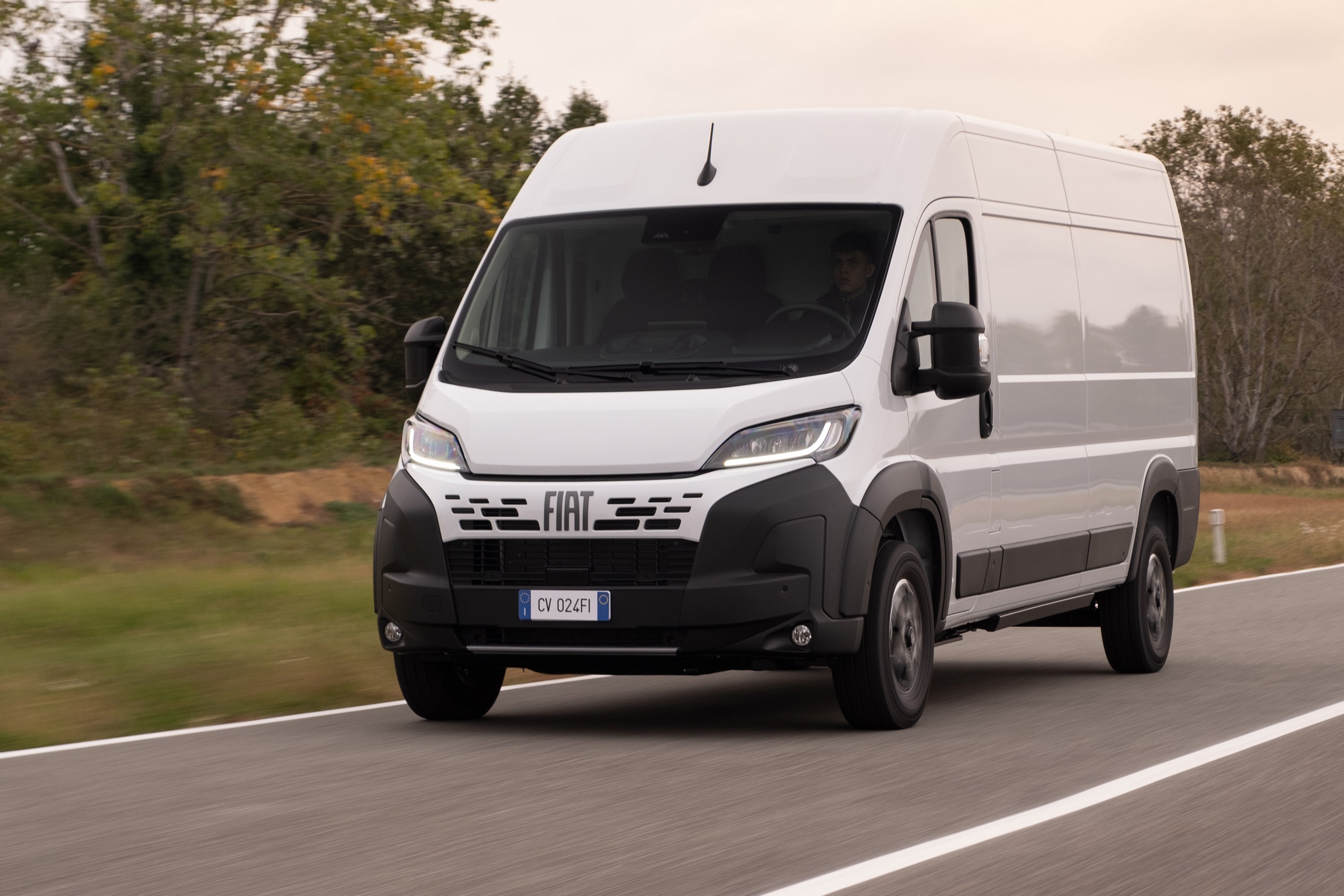Fiat Ducato Review 2025: Price, specs & load capacity
Written by Ivan Aistrop
Quick overview
Pros
- Brawny diesel engine
- Durable and hard-wearing
- Lots of space and practicality
Cons
- Could be more polished to drive
- Newer rivals have more versatile features
- Some might struggle with the driving position
Overall verdict on the Fiat Ducato
"Fiat is probably best known for its chic small cars, such as the 500 and Panda. However, the Italian manufacturer also has plenty of experience with vehicles at the complete opposite end of the size spectrum. It’s been making the Ducato - an offering in the large van class - since 1981."
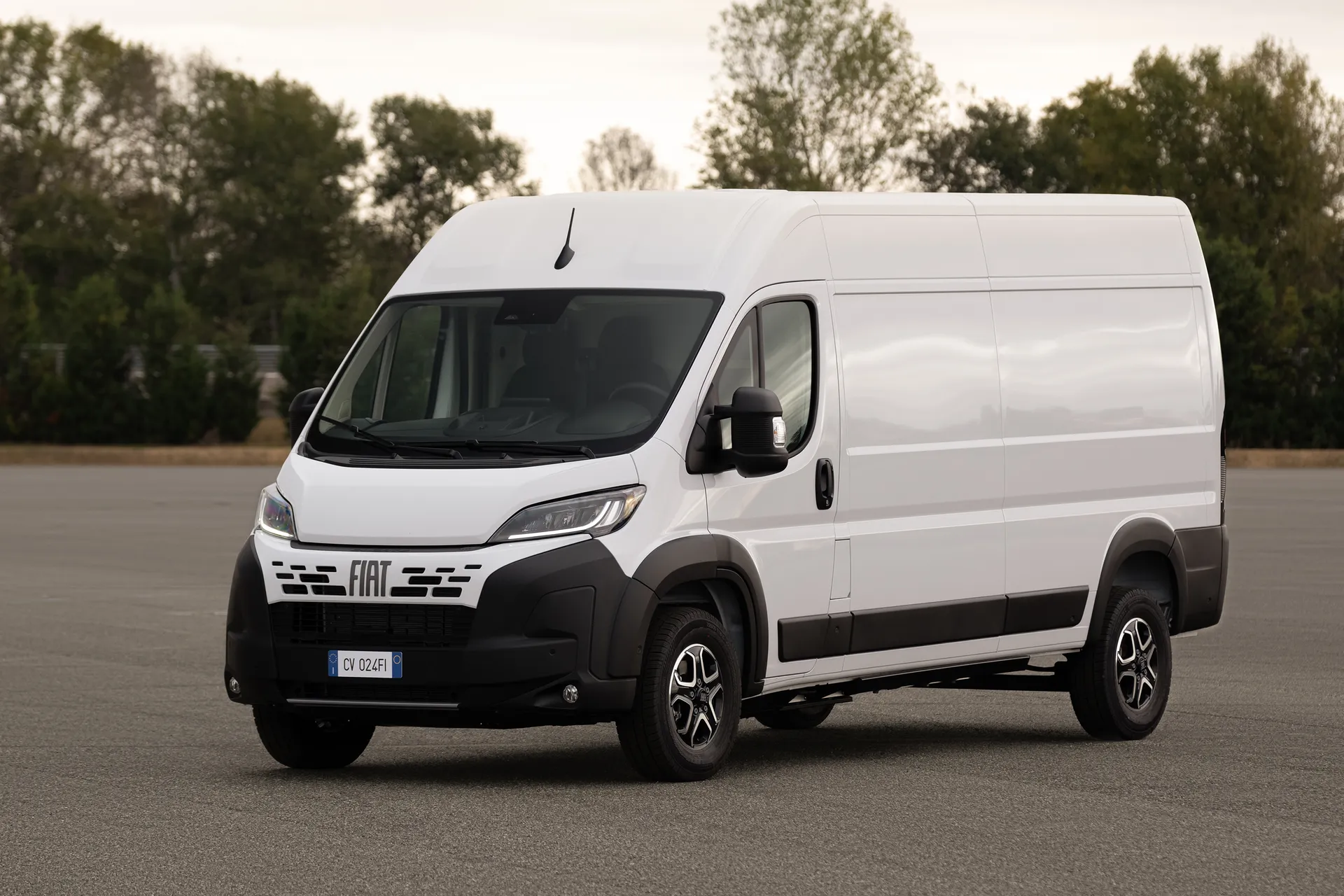
It originally came about thanks to a joint development and manufacturing agreement with Peugeot and Citroen, which saw the two French firms offer mechanically identical vans alongside the Ducato. This agreement has been in place ever since (with a small twist that we’ll talk about in a moment), and today, the Ducato shares its underpinnings with the Citroen Relay and Peugeot Boxer.
However, during the last several years of this joint development and manufacturing agreement, there hasn’t been a whole lot going on when it comes to the 'development' bit. You see, although the Fiat Ducato that you’ll recognise today was originally launched in 2014, it’s actually based mechanically on the previous Ducato, which has been in service since way back in 2006, making the mechanicals that underpin the current vehicle around two decades old. It’s pretty old-school to drive as a result, with a very unsettled ride and of-its-age refinement, but it still does pretty well in more practical areas, such as load space and payload.
Although there hasn’t been much change in the mechanicals born of this joint development agreement for the past few years, there has been plenty of change regarding the relationships between the companies involved. In 2021, the PSA Group (the company that previously owned and operated Peugeot and Citroen) and FCA (the company that previously owned and operated Fiat) entered a merger that saw the birth of a new multi-brand manufacturing powerhouse known as Stellantis. Vauxhall is yet another member of this multi-brand stable, and so the Ducato’s aged mechanicals have also been donated to the Vauxhall Movano in recent years.
And despite its advanced years, the Ducato doesn’t actually feel that old in many ways. Yes, it feels its age on the road, but the interior looks fine by modern standards, and there’s a very presentable amount of luxury and safety kit on board. That’s all thanks to the Ducato being updated almost constantly with new tech over the years to keep it competitive with newer rivals. Find a good deal on one, and the Ducato is a vehicle that could suit you and your business very well for several years to come.
Is the Fiat Ducato right for you?
If a large van is needed for your business, then the Fiat Ducato might well fit the bill. Not only does it do a great job on loadspace and practicality, but there’s also plenty of choice available regarding the length, height and bodystyle of your vehicle, plus a variety of at-cource customisation options on offer to tailor your Ducto perfectly to the nature of your work. Diesel and all-electric powertrains are also available to suit both long and short-distance work.
What’s the best Fiat Ducato model/engine/battery to choose?
The Ducato is available in a vast variety of different forms to suit a wide range of business needs, and although that gives you lots of choice, it also makes your choice rather complicated. Essentially, we’d advise going for a version that’s as small as you can get away with, because that will reduce what you’ll pay to buy and run your van. However, make sure that the van is still big enough that you can carry out your work quickly, easily and efficiently.
If your work is confined exclusively to your local area, then choosing the all-electric Ducato might save you a few quid in running costs, although it’ll cost more to buy in the first place. If your work takes you further afield, though, then it’ll have to be one of the diesels.
What other vehicles are similar to the Fiat Ducato?
It’s not difficult to find a vehicle like the Fiat Ducato: there are plenty that are not only similar, but they’re pretty much identical, both mechanically and to look at. These are the large vans offered by Fiat’s sister brands from within the Stellantis manufacturing stable, and these include the Citroen Relay, Peugeot Boxer and Vauxhall Movano.
Obviously, the Stellantis Group isn’t the only firm that makes large vans. Other rivals on the large van market include the full-size Ford Transit, Mercedes-Benz Sprinter, Renault Master, Nissan Interstar, Iveco Daily, and Volkswagen Crafter.
Comfort and design: Fiat Ducato interior
“The Ducato’s dashboard design is nice and simple by modern standards. There are physical buttons and knobs for controlling the air-con and a few other minor functions, which is much less distracting than having to use a touchscreen. These controls are located in the middle of the dashboard where you expect to find them, and they’re all clearly marked and easy to operate.”
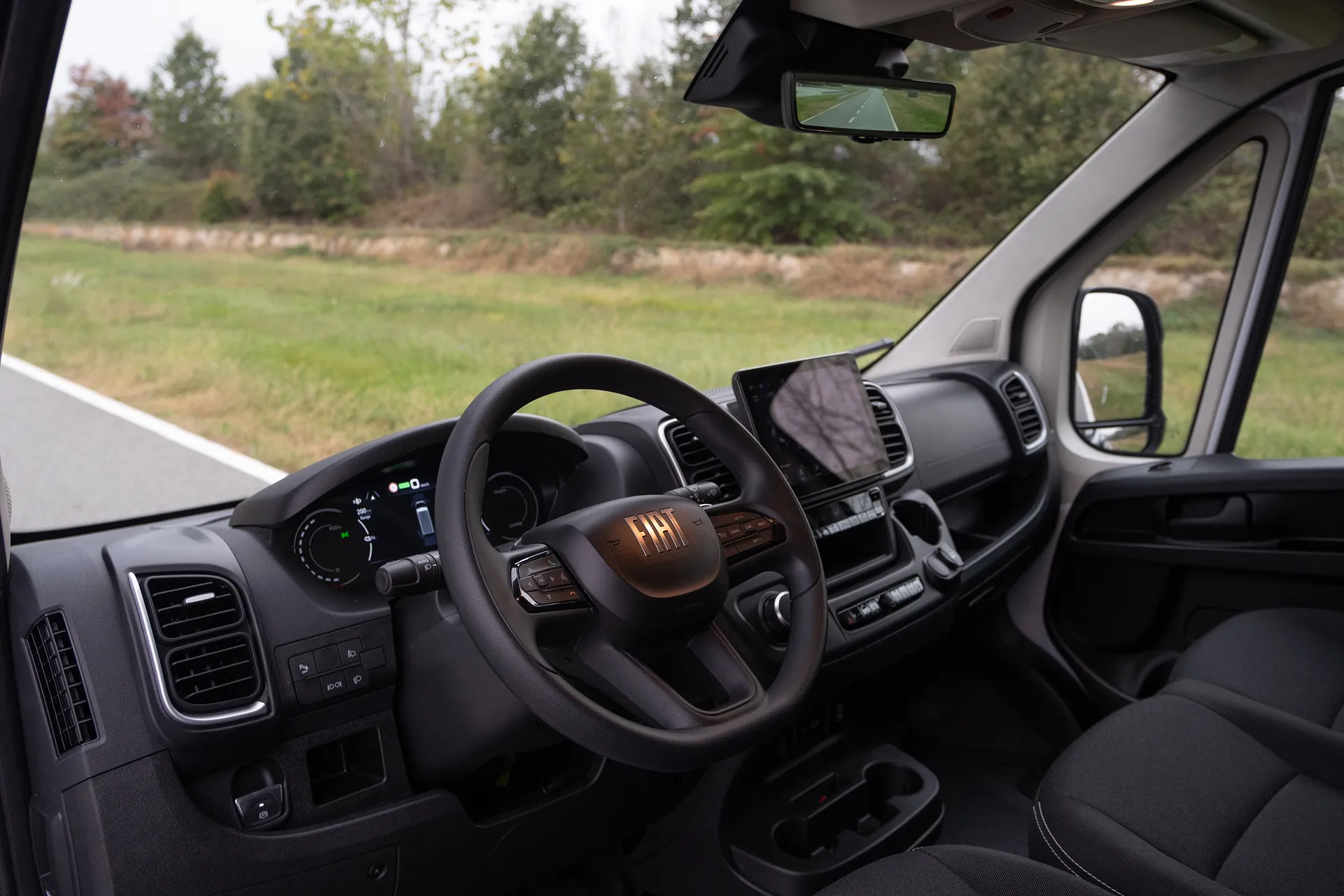
Things were made even better on that score during the 2024 facelift when the dashboard was redesigned for a smarter, less cluttered look. Those aims were certainly achieved, while the layout remained nice and intuitive.
Unfortunately, finding a comfortable driving position is rather less intuitive, and that’s because the various adjustment mechanisms are very unconventional. For example, in most passenger cars and small vans, you crank your seat up and down using a single ratchet lever. In the Ducato, meanwhile, you get two catches on the side of the driver’s seat that change the angle of its base (the bit you sit on): one of these catches changes the angle from the front of the base, while the other changes the angle from the back.
Essentially, you have to muck about with these until your seat base winds up at the desired height (which will probably only happen by accident), and then you level the seat off. It not only takes time to figure out how the mechanism works, but even when you’re familiar with it, making your intended adjustments is a time-consuming and imprecise business. The steering column adjustment is also pretty weird because the wheel moves for reach but not height.
Even when you get all the various adjustments right, the driving position still feels awkwardly upright. You’ll also find that the pedals are placed a long way below you, so you have to angle your feet in an awkward way to reach them.
More positively, the lofty driving position does give you a good view of the road ahead, purely because you can see over the top of most other traffic. However, your forward visibility is still hampered by thick windscreen pillars that can block your view at junctions, and when you're trying to keep an eye on the inside kerb as you turn a corner, your view of it is blocked by those same pillars, plus the massive door mirrors.
Those massive door mirrors are a boon where your rear visibility is concerned, though, and happily, all versions of the Boxer get rear parking sensors as standard. However, you might want to consider adding one of the various option packs available that adds a reversing camera: one of these makes parking such an enormous vehicle considerably easier.
Quality and finish
As a hard-working commercial vehicle, it’s important that the Fiat Ducato’s interior finish is centred around durability and functionality rather than any aspiration of poshness. You want your interior surfaces to be wipe-clean and scuff-resistant, and never mind about anything else.
In that regard, the Ducato’s cabin is exactly what you expect. Pretty much all the surfaces you see are fashioned from hard plastic, although a few of them are textured in such a way that they appear to be a little more enticing than they actually are. Primo models get chromed air vents for a little splash of extra colour. The various switches and buttons work with slick precision.
Infotainment: Touchscreen, USB, nav and stereo in the Fiat Ducato
The Ducato has been on sale for such a long time that it’s no surprise that the makeup of its infotainment system has changed quite a bit over the years. Early entry-level examples were very basic indeed, with just an FM/AM radio, Bluetooth USB port and aux-in input, while mid-range versions and upwards had a five-inch touchscreen with DAB and integrated navigation. We never got to experience either system, though.
Today, if you buy your Ducato in standard trim, then the infotainment system you get differs according to what powertrain you select. Go for a diesel, and you get analogue dials behind the steering wheel and a small five-inch central infotainment touchscreen with Bluetooth, DAB and a USB port. On the EV, your central screen is upgraded to a seven-inch item, while those analogue dials are replaced by a seven-inch digital instrument screen.
We’ve never experienced either setup, though, because all Ducatos we’ve driven have been in top-level Primo spec, which gets a big upgrade in infotainment tech, regardless of your powertrain. This includes the digital instrument panel and a larger 10-inch central screen with integrated navigation, Apple CarPlay, Android Auto, wireless phone charging and more USB ports. The pack also adds automatic climate control.
The system is nowhere near as complicated as the systems you see in many vehicles nowadays, and that makes it easier to find and use most of the various functions.
Space and practicality: Fiat Ducato cargo space
The Ducato is designed to cater for a wide variety of business needs by being offered in a wide variety of different forms. Alongside the well-known panel van variant, the vehicle can also be had in other formats including as a Window Van, Chassis Cab, Chassis Crew Cab, and Platform Cab. Pick the panel van, which we’re mainly concentrating on here, and you choose between three different roof heights (H1, H2 and H3), three different lengths (L2, L3 and L4), and two different Gross Vehicle Weight (GVW) options (3.5 tonnes and 4.25 tonnes). Go back further in time, and even more length and GVW options were offered, but these have since been discontinued and are too numerous to go into here.
In all versions of the modern-day Ducato, the width of the loadbay - when measured between the wheel arches - comes in at 1,422mm. Depending on the choices you make over the height and length of your Ducato, your loadbay will measure between 1,662mm and 2,172mm tall and between 3,120mm and 4,070mm long. The figures for overall load volume look correspondingly impressive: even the smallest iteration (the L2 H1) has a load capacity of 10 cubic metres, while the largest Ducato (the L4 H3) has a huge figure of 17 cubic metres.
If you’re one of those users for whom payload is more important than capacity, then the precise permissible figure of your van will depend on its size and powertrain. The smallest version of the all-electric e-Ducato has a figure of just 710kg, but all other electric versions have much better figures, sitting between 1,385kg and 1,460kg.
Those after maximum payload will probably want one of the diesels. The lowest figure on these is 1,235kg, but most of the diesel range sits at around the 1,400kg mark, while the biggest figure achieved is a whopping 2050kg.
If you need to tug trailers as well as lug loads, it’s handy to know that all the electric versions of the Ducato are rated to pull a braked trailer of up to 2,400kg: that figure is actually really good, because electric vehicles are often a bit rubbish where this is concerned. The diesels still have the edge, though. A handful of versions have a figure of 2,250kg, but the vast majority will pull either 2,500kg or 3,000kg.
When it comes to getting access to your load space, all examples of the panel van get a pair of doors on the back end, and these have the ability to open at up to 180 degrees for easier access. There’s a sliding door on the nearside of the vehicle included in your standard equipment, and a second sliding door can be added on the other side if you pay a few hundred quid extra.
The Ducato panel van has three seats up front, positioned side-by-side, and there’s sufficient space for three colleagues to travel reasonably comfortably without having to become too overfamiliar.
Handling and ride quality: What is the Fiat Ducato like to drive?
"If you’re spending vast portions of your working day at the wheel of your van, then comfort is the dynamic attribute you want above all others. Unfortunately, that’s where the Ducato’s dynamic performance is a little behind the curve."
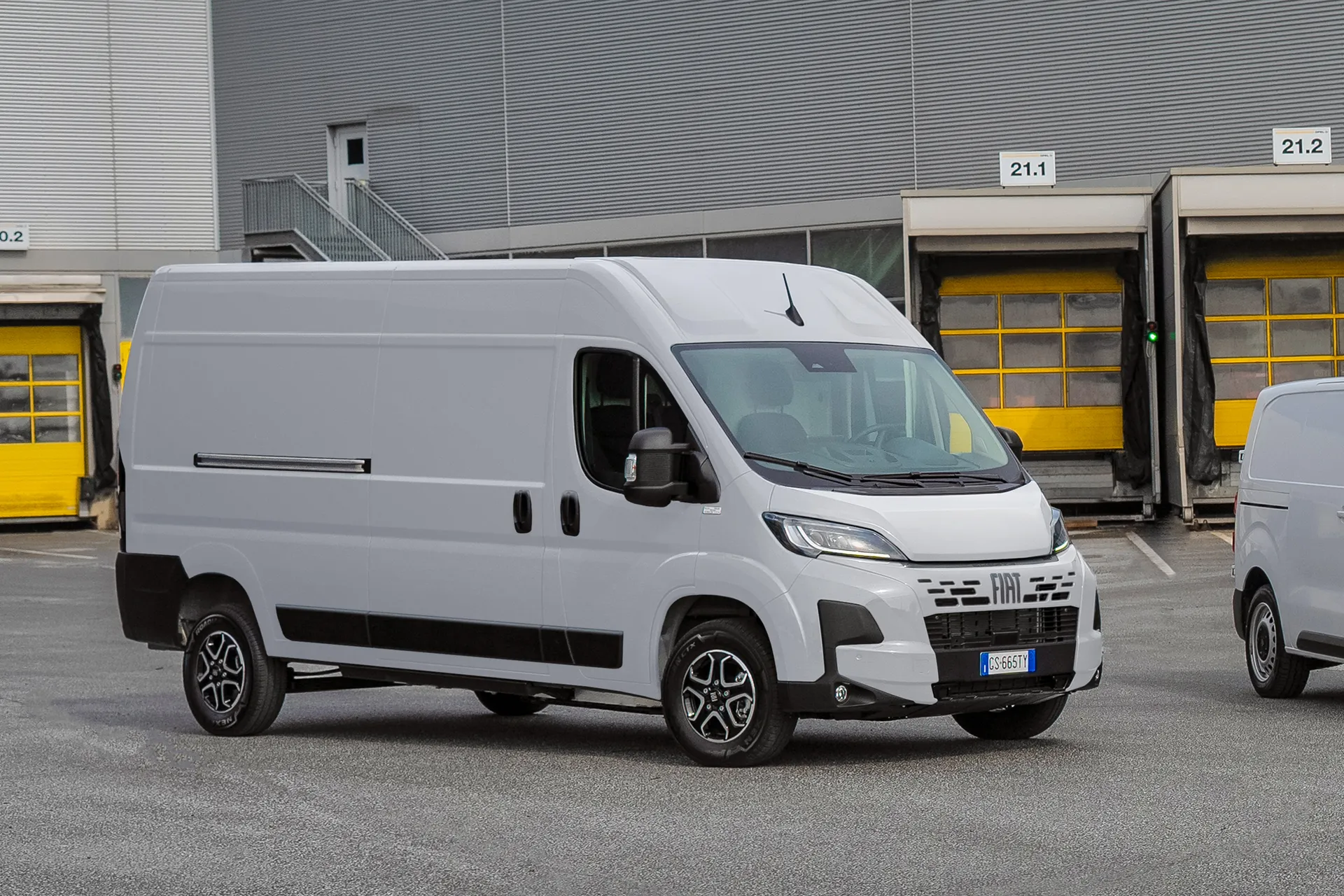
Even on seemingly pristine road surfaces, the suspension feels jittery and bouncy, and while you’ll notice a marginal improvement once some heavy cargo gets loaded into the back, there’s still a decidedly unsettled feel. Encounter bumps and potholes meanwhile, and the suspension also starts to feel rather crashy, and that’s the case whatever your speed. None of this comes as any great surprise when you realise that the platform on which the Ducato is built traces its origins way back to 2006, so it’s very old kit, but that doesn’t change the fact that several of the Ducato’s rivals are more comfortable.
Cumbersome handling is far more forgivable in an enormous vehicle like the Ducato: depending on which version you choose, it measures between 5.5 and 6.5 metres long. And sure enough, you need to keep your wits about you when piloting the thing, keeping an eye on the extremities of the vast body and making sure to keep your speed down. Not that you’ll ever be tempted into going too fast, mind, because you get virtually no reward for doing so. Getting your speed up in something huge is just too stressful unless you’re on a long, straight motorway with lots of space around you.
Once you become used to the Ducato’s massive size, though, you might actually be quite surprised by how easy it is to manoeuvre about the place. That’s thanks to clear forward visibility and extremely light steering that hardly requires any muscle. The steering is also very slow, however, and that means that your arms will be flying around all over the place when turning the steering wheel from lock to lock during manoeuvres. At least the plentiful articulation of the front wheels means that the turning circle is actually not as massive as you might think.
What engines and gearboxes/motors and batteries are available in the Fiat Ducato?
With the Ducato having been around for such a long time, it’s no surprise that it’s been offered with a vast variety of different engines over time. It started life with 2.2-litre diesels of varying outputs, and then switched to 2.0-litre units in 2016 to comply with changes in emissions laws, before returning to 2.2s later on. We never got to try any of the early engines, unfortunately.
In the present day, the vast majority of Ducatos are powered by a 2.2-litre diesel engine with 140PS. You can specify this with either a six-speed manual gearbox or an eight-speed automatic transmission.
The manual will be fine for most. The engine always feels muscular, even right at the bottom of the rev range, so it builds speed at a very decent rate without you having to work it to its limits. And if you do work it, then the acceleration you get feels like it’s too much for a vehicle like this.
The sheer mass of the Ducato means you might well need to make a downshift when the traffic in front of you slows up, but that’s not much of a hardship. The automatic transmission, meanwhile, is smooth enough and seems to keep the engine within its power band pretty effectively, without over-revving it.
There’s also a 180PS version of the 2.2 diesel, offered both as a manual and an automatic, but we haven’t tried it yet.
If you’re considering an electric Ducato, early pre-2024 examples had a 120PS motor and a battery of either 47kWh or 79kWh, but we never got to try these versions. During the 2024 facelift, the electric powertrain was completely overhauled to feature a much larger 110kWh battery and an electric motor with a maximum power output of 279PS and maximum torque of 410Nm.
Now, those numbers might not mean a great deal to you, but trust us when we say that they’re quite high: what you might expect in a hot hatch rather than in a massive cumbersome lump like the Ducato. And, even in such a large and unwieldy vehicle as the Ducato, they’re enough to deliver a surprising turn of speed. You pick between three driving modes: turn your Ducato on and Normal mode will be automatically preselected, but using the small button to your left, you can select Power mode to sacrifice a little bit of range in order to maximise performance, or select Eco mode to do exactly the opposite.
We can say with confidence that for any driving situation short of a drag race - and you don’t often see large vans entered into those - you won’t be needing Power mode. Whether you’re getting away from the mark or picking up speed on the move, the rate of forward motion you feel is actually a little too quick for comfort in a big, clumsy vehicle like the Ducato. The official figures say 0-62mph in 10 seconds, but it feels quicker, especially given the sheer mass you’re carrying. Nail the throttle, and you might well find yourself muttering rude words under your breath in surprise.
In Normal mode, your acceleration feels only a fraction behind what you get in Power mode, and while there’s a bigger deficit in on-the-move pickup, you’ll still have more than you’ll know what to do with. Even in Eco mode, you’ll get away from the line quick enough to surprise many other motorists, although your on-the-move pace is reined in rather more, and your top speed is limited to 56mph. Even so, there’s enough go on tap to roll around in Eco for the majority of the time and save your range in the process, and you’ll only need to switch up to Normal mode for motorways and other higher-speed work, such as overtaking and sliproads.
Fiat E-Ducato electric range: How far can you travel on a charge?
The electric Ducato was first released in 2021 and it came with a battery pack of either 47kWH or 79kWh. Either way, the range wasn’t brilliant. Most versions with the smaller battery would struggle to crack 100 miles on a full charge, according to official figures, while even with the bigger battery, the range was still limited to around 150 miles.
One of the biggest parts of the Ducato’s 2024 facelift was that the electric powertrain was completely overhauled. The weeny batteries were replaced by a much larger 110kWh pack (that’s total capacity, while 97.8kWh of it is usable), and that gives an official WLTP range of between 235 and 262 miles, depending on the version. That’s very good compared with most electric vans.
With any electric vehicle, though, car or van, these figures should be treated very much as a best-case scenario. You’ll do extremely well to replicate these laboratory figures in the real world, and that’s if you’re running around with an empty loadbay: stick some cargo in the back, and you won’t stand a chance. You’ll also see your range readout tumble on the motorway at high speeds and in cold weather, both of which are things that EVs really don’t like.
Refinement and noise levels
As you’d expect, you hear much less mechanical noise in the electric version of the Ducato than you do in the diesel. The electric motor barely makes a sound for the vast majority of the time, while in contrast, the diesel engine clatters away in the way that diesel engines do. That din can get quite loud if you find it necessary to really rev the engine, but it has sufficient muscle that you really don’t have to very often to maintain a very decent pace. And by the time you’re up to motorway speed, the engine noise melts away into the background.
It’s replaced at those speeds by another source of noise, though, and not one that you might be expecting. With the Ducato’s bluff shape, you might well expect wind noise to be the main culprit, but you actually hear very little of that. You do, however, hear a great deal of road noise: you first notice it at moderate speeds, and by the time you’re up to motorway cruising pace, it’s loud enough to be slightly annoying.
Obviously, the electric Ducato doesn’t have a gearbox (the vast majority of EVs have a single-speed transmission), so your acceleration has a linear and uninterrupted feel. With the diesel, the manual gearshift is slightly notchy but not uncomfortably so, while the automatic gearbox option swaps cogs in a smooth and timely manner, making for more relaxed progress.
Whichever gearbox you choose, you’ll find that the diesel engine constantly transmits vibrations to your hands and feet through the steering wheel and pedals, and in manual models, it comes through the gear lever, too. It’s nothing that’ll cause you any discomfort, though.
Safety equipment: How safe is the Fiat Ducato?
The Ducato has existed for so many years and been updated on so many occasions during that time to keep it fresh that there have been almost constant changes to the amount of standard safety equipment provided, and documenting them all to take all day. The general rule of thumb is that more and more was added incrementally as time went on, so if you’re buying a used Ducato, buy the latest one you can afford.
These days, the amount of standard safety kit you get depends on which of the two trim levels you go for. The base-level Ducato gets a suite of safety measures that includes three front airbags, automatic emergency braking, traffic sign recognition, intelligent speed limit assist, lane support, driver drowsiness detection and reversing sensors.
The Primo version, meanwhile, adds 360-degree parking sensors, a digital rear-view mirror, blind spot assistance, and rear cross-traffic alert.
More safety measures are available on the options list, with side and curtain airbags available for a few quid extra, while the Ducato is the only large van of the Stellantis quartet that allows you to add adaptive cruise control as part of an option pack.
That Stellantis quartet of vans has achieved the Gold award in Euro NCAP’s Commercial Vehicle safety ratings, which is the second-highest accolade behind the Platinum award. While this sounds very impressive at first, it becomes a little less so once you learn that of all the vans ever tested under the programme, all but one has achieved one of the top two levels.
MPG and fuel costs: What does a Fiat Ducato cost to run?
"The engines in diesel-powered Ducatos from after the 2024 facelift are 9% more efficient than those that went before. So, if you want to maximise fuel economy and can afford to buy a newer van, go for one of those."
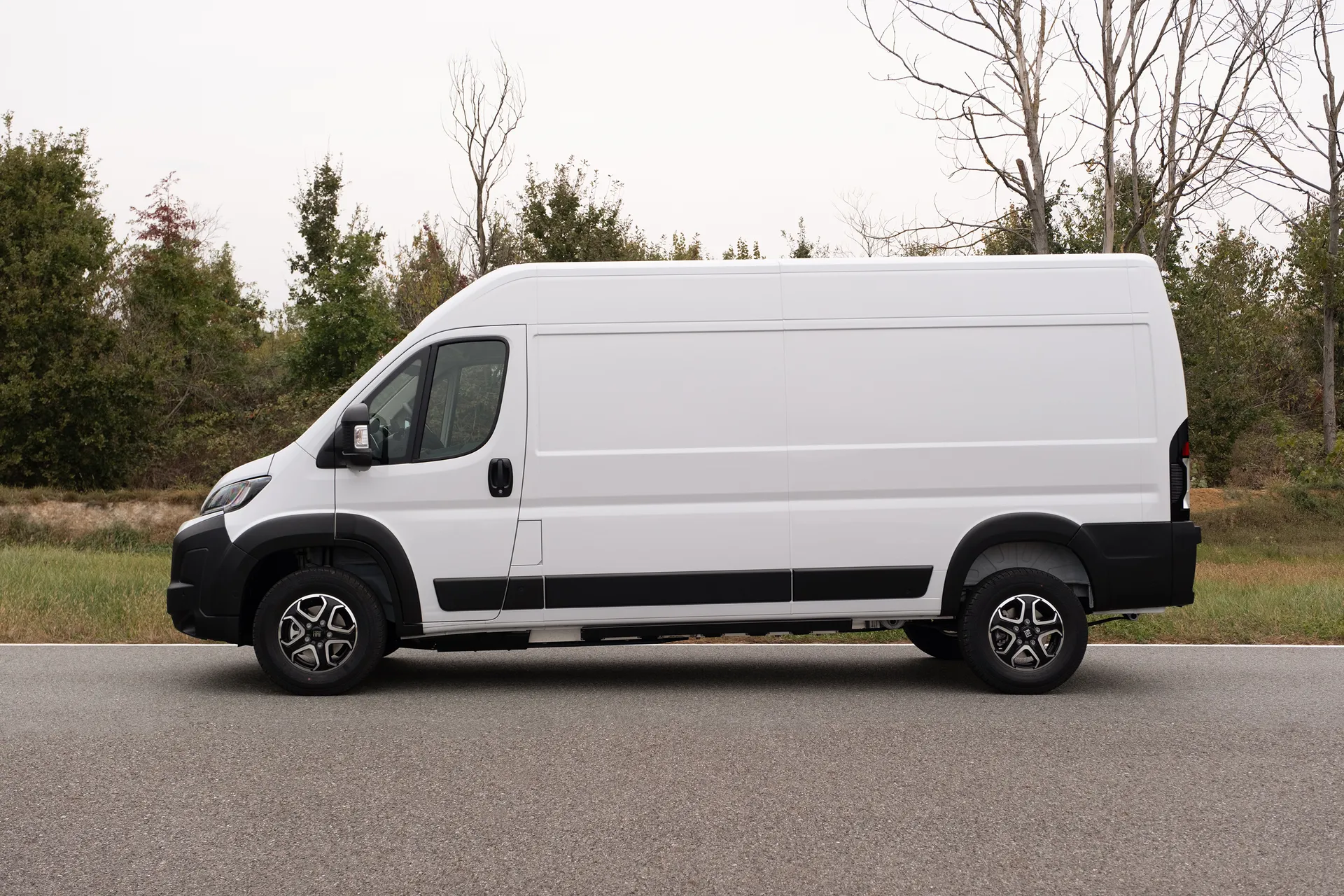
To quantify things, these later vans have official WLTP maximum combined cycle figures of between 37mpg and 44mpg depending on the version, but minimum figures of between 21mpg and 31mpg, so the spread is quite broad. In theory, that should mean an average return in the mid-to-late thirties. You'll still do very well to match that in the real world, though, particularly when your Ducato is loaded up with weight.
Charging times: How much does it cost to charge the Fiat E-Ducato?
Fiat’s data on charging times for the older 47kWh and 79kWh versions of the e-Ducato is a little sketchy and incomplete. We’ve seen a figure of just under eight hours for the smaller option when charged on a normal 7.4kW domestic wallbox charger, and although we’ve seen no equivalent figure for the larger battery option, we’d estimate that it’d be around 12 to 13 hours.
Both of these versions support DC rapid charging of 50kW, and Fiat says that on a sufficiently powerful public charging station, the smaller battery option can be replenished in 55 minutes, while the larger battery takes 85 minutes.
The 2024 facelift brought vast improvements in both battery size and DC rapid charging rates. The new 110kWh battery could be charged at up to 150kW on an appropriately powerful DC rapid charger, delivering a 5-80% charge in 55 minutes despite the vastly increased capacity.
That increased bigger capacity means much longer charging times when using the usual 7.4kW home wallbox charger, though. You’ll be looking at 16 hours and 40 minutes, according to Fiat’s figures.
Home charging is the most cost-effective method, with a full charge of the big post-facelift battery costing you around £31 if your domestic power is charged at the UK’s national average. Don’t rely on DC rapid charging stations too often, though, because the power that comes out of those usually costs three times as much, sometimes more.
Fiat Ducato reliability and warranty
On the subject of reliability, we have bad news where Fiat is concerned, but good news on the Ducato. How so? Well, the bad news for Fiat is that in the latest edition of the HonestJohn.co.uk Satisfaction Index, the brand was named as the third-worst manufacturer in the entire study for reliability, among a field of 29 carmakers.
The good news for the Ducato, though, is that the study only takes passenger cars into account and not commercial vehicles. So, the Ducato can in no way be held responsible for any part of this dreadful performance, and it’s mechanically completely unrelated to any vehicle that did contribute. Even so, it’s not a result that fills you full of confidence about the Ducato’s potential reliability.
More confidence-inspiring is the Ducato’s reasonably generous warranty, which comprises two years of manufacturer cover with no mileage limit, plus a third year of retailer-supplied cover with a 100,000-mile limit.
The battery in the electric version, meanwhile, is warrantied for eight years or 100,000 miles. If it drops below 70% of its original capacity during that time, then it’ll be repaired or replaced for free.
Fiat Ducato insurance groups and costs
Go for a Ducato with a diesel engine, and the chances are that it’ll fall into insurance groups 37 or 38 (of 50, with group 50 vehicles being the most expensive to insure): there’s just one diesel variant that doesn’t sit in those two groups, sitting in group 39 instead.
Go for the e-Ducato, and the one version with a GVW of 3.5 tonnes falls into group 39, while the rest fall into groups 43 and 44. This won’t be a cheap van to insure, then.
VED car tax: What is the annual road tax on a Fiat Ducato?
Ducatos fall into two vehicle tax categories. Those with 35 in the name (that’s most of them) have a Gross Vehicle Weight (GVW) of 3,500kg, while those with a 40 in the name (that’s all but one of the electric ones and a handful of the diesels) have a GVW of 4,250kg.
Vans with the lighter GVW are taxed as Light Goods Vehicles (LGVs), and are liable for a flare rate of annual VED tax, currently charged at £335 per year.
Those with the heavier GVW, meanwhile, are taxed as Heavy Goods Vehicles (HGVs), and in these cases, there's much more variation in the amount you pay. The best thing to do is to obtain the precise class applicable from the vehicle’s V5C document and then check online or with the DVLA.
Fiat Ducato price
"If you’re considering a brand new Ducato, then prices start at around £32,000 (excluding VAT) for the cheapest version of the panel van. These prices rise to around £39,000 for the bigger, heavier versions with punchier engines and automatic gearboxes."
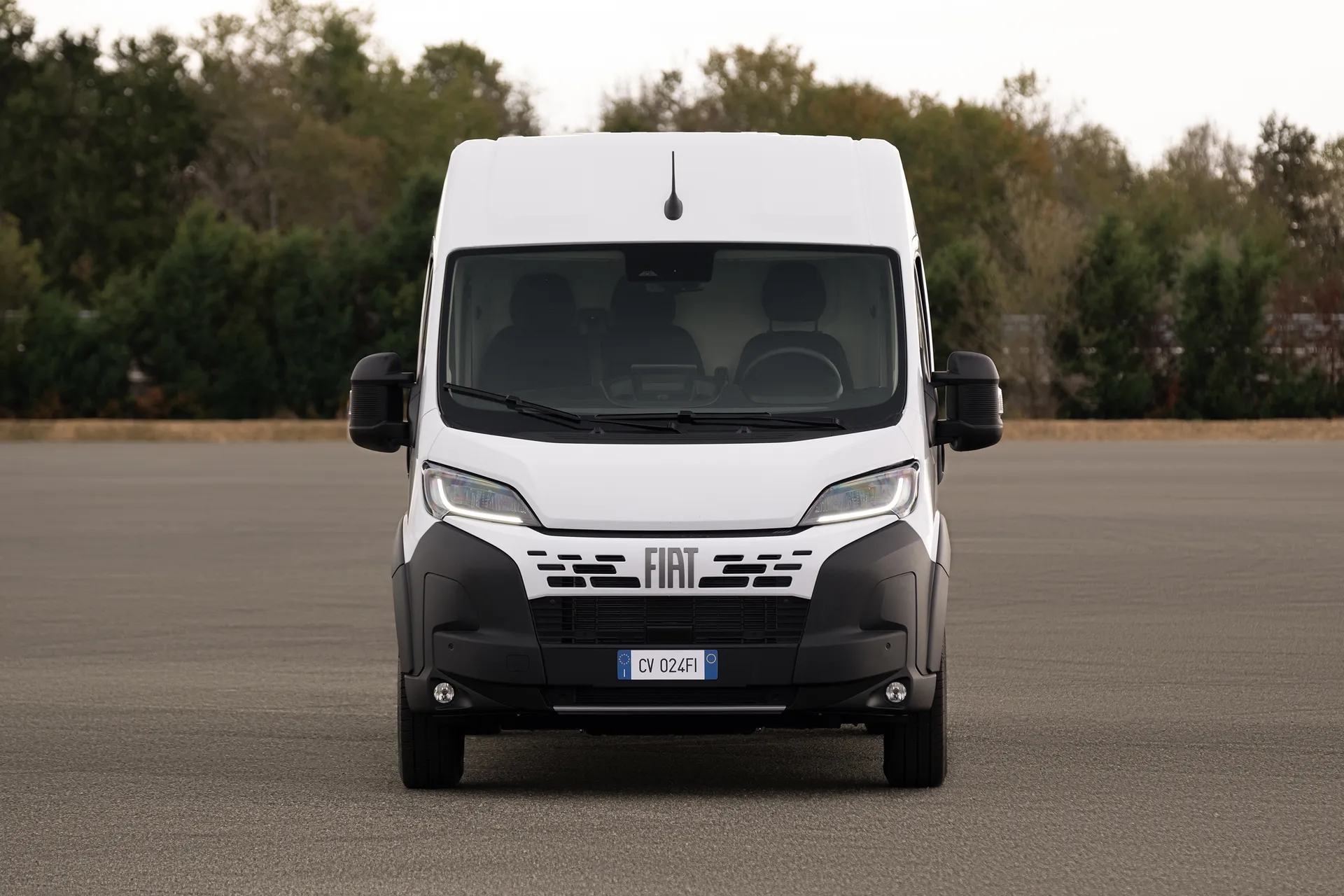
If you’re more interested in the e-Ducato, then the list prices are rather steeper, ranging between £50,000 and £53,000 (again, excluding VAT). However, what you’ll pay can be trimmed by five grand if you qualify for the Government’s Plug in Van Grant (PiVG).
Whether you’re considering diesel or electric, Window Van variants sit at the upper end of the scale, while Chassis Cabs sit at the lower end. Select higher-end Primo trim, and you’ll be paying around £3,500 more than if you stick with the standard Ducato.
If you’re not bothered about having a brand new Ducato, though, then you can save yourself a packet by getting yourself a used one. Check the heycar classifieds, and you’ll find several diesel examples from around 2019 or 2020 hovering at around the £12,000 mark. Mileages will be upwards of 65,000 miles at that money, but that should be no issue as these things are built to last.
You’ll even find a handful of e-Ducatos in our listings, but these will be almost new, with only a few delivery miles on the dial, and will be a lot more expensive as a result. Prices from around £30,000 still represent a very useful saving, though.
Trim levels and standard equipment
Like we said earlier, the Ducato has been around for so many years and received so many updates along the way that documenting all the various trim levels that have been offered over the years, and the equipment they come with, would take all day. Again, be aware that more and more kit was added incrementally over time, so if you’re buying used, then the later the vehicle you buy, the more kit it’s likely to have. However, do bear in mind that many of the most basic versions over the years have been too basic. You’ll definitely want air-con and reversing sensors, things that entry-level models didn’t have until reasonably recently.
Today, the Ducato is offered in a choice of two trim levels. The entry-level one - imaginatively called ‘Ducato’ - has slightly different kit levels depending on whether you choose the electric version or the diesel version.
For example, the diesel has a manual parking brake and manual air-conditioning, while the EV has an electronic parking brake and automatic climate control, and the EV also chucks in keyless entry and go as well. That said, the diesel Ducato gets cruise control, while the EV doesn’t.
On both, your standard kit list includes rear parking sensors, electrically adjustable and heated twin-lens door mirrors, electric front windows, and fabric upholstery. You’ll also find that there are some differences between the two versions on the infotainment kit, and we’ve outlined those in the Infotainment section of this review.
Regardless of fuel type, the top-of-the-range Primo model gets the climate control, electronic parking brake, keyless entry and go, and you also get niceties such as automatic lights and wipers, LED headlights with automatic high beam function, fog lights with cornering function, power folding mirrors, smarter wheel trims, chromed interior air vents, and a leather steering wheel. You also get the vastly upgraded infotainment setup and a few additional bits of safety gear, and again, we’ve given you the lowdown on these in the corresponding sections of this review.
Ask the heycar experts: common questions
Is the Fiat Ducato a van?
Is the Fiat Ducato any good?
Is the Fiat Ducato electric?
Get our latest advice, news and offers
Keep me updated by email with the latest advice, news and offers from heycar.
By submitting you agree to our privacy policy
